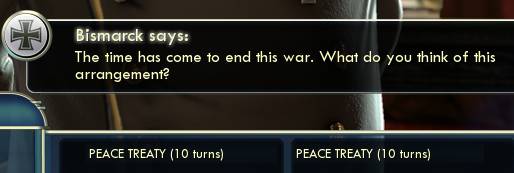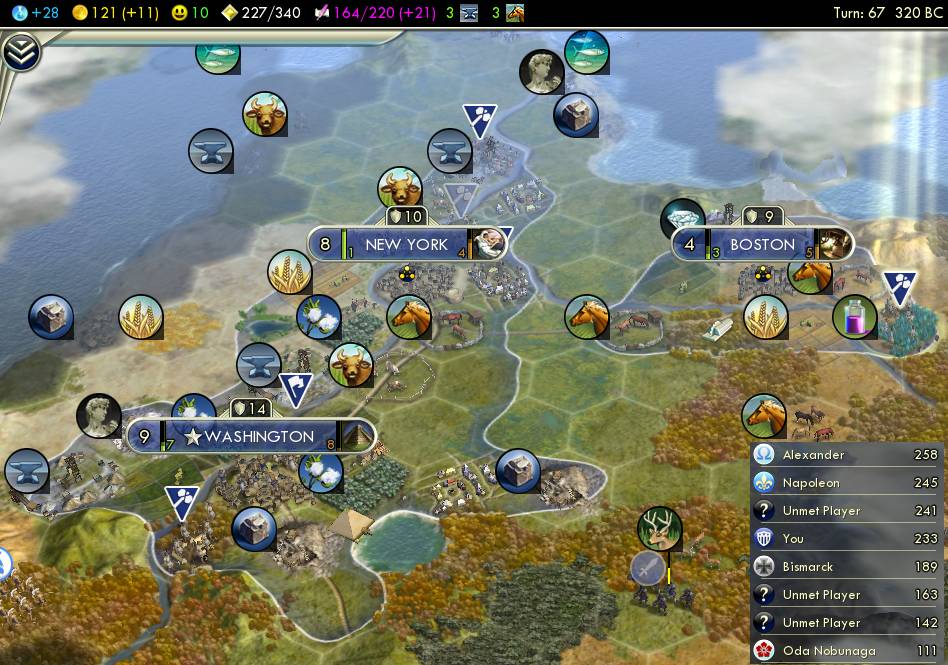Here we go!
My first thought is that Washington's powers seem really weak. +1 sight is lame, and a discount to purchase tiles seems pretty limited. But I wouldn't be surprised at all if they were intentionally designed as novice-friendly crutches for your average American gamer likely to pick America. The extra sight makes more stuff happen quickly in the early turns, perhaps a necessary concession to today's hypercaffeinated attention spans.

So here's my very first Civ 5 screenshot, after moving the warrior to scout. He moved south because somehow the settler couldn't see that direction; maybe the game isn't smart enough to apply Washington's sight bonus on initially spawning and only after the units move? Anyway, the best location looks to be 1 NE (I guess that's how we define directions on the hex grid?), pulling the 2-0-3 river cotton into first ring, 3-0-1 cattle into second, and wheat and the extra stone into third ring. (I have no sense yet how long it takes to expand to these distances.)

And here's the city. Took me a little while to understand my way around the city screen here, in particular how the city could have a whopping production of 6 hammers, then saw that the Palace gives +3. (Odd mechanic, sounds like it may be the first of many unearned freebies, but I digress.) The purple outline around the cow means that the city will pick that tile next, so I don't need to buy it, if I'm understanding correctly.
So I went worker first, since the timing for everything worked out together. Animal Husbandry was 7 turns to research, the worker 8 turns to build (after switching from the 2-0-3 cotton to 2-1-0 stone), and the border expansion 10 turns to the cow. I've vaguely read of some openings that go monument first to start getting free stuff from the social policies, but for now in my first game I shall stick to the basics.
My warrior explored easterly, contacting Japan. Then he diverted southwards; I know there's a lot of stuff that depends on first contact or exploration, so I didn't want to spend time exploring land that Japan already had. Hey, maybe that sight bonus isn't too bad: my warrior found an Ancient Ruin. What does that do?

Ha. Nice. Also I now had the 15 gold to buy the cattle tile, so did so and put it to work right away. I'm aware that food is not so important on the later stages of the Civ 5 growth curve, but for now it does seem right to start the snowball immediately. Then I noticed that the ruins pop bumped the food cost to grow a citizen from 10 to 16. Yikes, that's not very efficient at all! Really that ruin gave me only 4 food because of the escalated growth cost. Hmm.
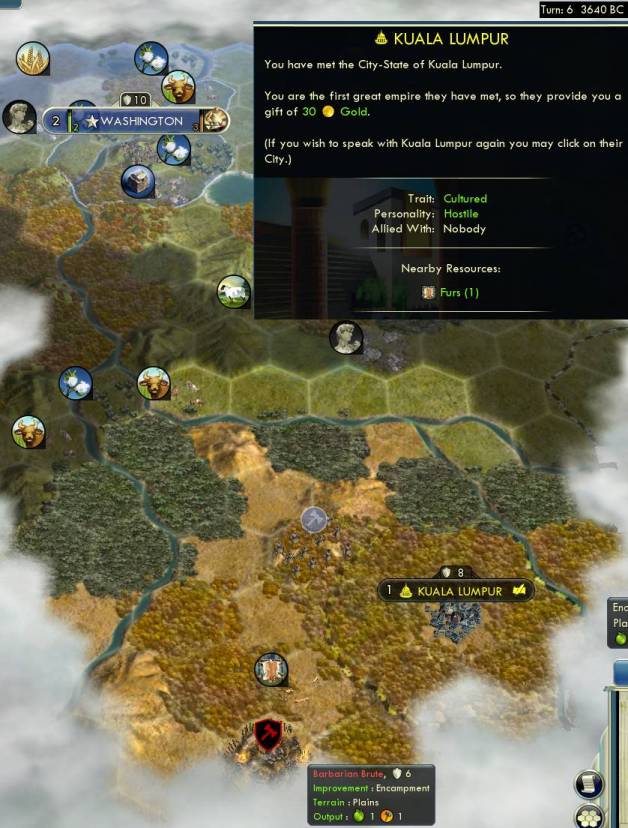
Down south I proceeded to find my first city-state, Kuala Lumpur, who handed over 30 gold. And a barbarian camp. I've read that you should wait until they say to clear it, then do so. My warrior continued to find two more ancient ruins, but nothing exciting happened here: a map and a barbarian encampment that spawned near Japan. Two more ruins came into view near home, which popped 80 gold (nice!) and 13 culture which feels extremely weird to this Civ 4 veteran.
Animal Husbandry revealed horses within range of Washington. (That first-turn move really turned out well!) So the next tech to go for looked like The Wheel, with a snowball-advancing building (Watermill for +2 food +1 hammer) and a strong military unit.
Next came Horseback Riding. No, I hadn't planned on an extreme military beeline, but hey, go with it. That Stable adds 2 more hammers to Washington for more snowballing, and those Horseman units were well known for ruling the world at least in earlier Civ 5 patches. And no other tech option seemed compelling enough. Granaries are weak, we didn't have anything to mine, and don't need archery with a horse unit beeline. Then yet another ruin popped Archery anyway.
Washington's build order was worker - scout - monument - watermill. Now it was Social Policy time... yeah, Liberty for the fast expansion looks right. I took the worker policy first, lacking the happiness to settle just yet. Then I realized you can't stack workers to improve faster. Duh, of course.
Then I finally happened to mouse over the marble, to realize that's a happy resource too! Who knew! Okay, next research path on up to Masonry.

Anyway, here's the new city. It put me into unhappiness, but just briefly until Calendar finally arrived to improve the cotton. About a dozen popups exhorted me to connect it by road for Big Profits, so I did. But I didn't understand what that actually did, since I didn't see any improved gold or science production in the city screens. A hundred or so turns later I finally found the screen that shows trade route income (a mouseover on F2) to learn that trade routes pay roughly 1 gold per population, which pretty much just nets out against the road upkeep cost for much of the game.
Pottery had just come in on the way to Calendar, so I bought the granary for the new city. Back in Civ 3, rushing a granary for each new city ASAP was the strongest thing you could do for its growth curve, and even in Civ 4 a chopped granary is just about the strongest play too. It was +3 food with the wheat here, not as strong as the older versions of the granary, but still seemed worthwhile. I might have outsmarted myself here though, might have been better to spend the gold on city-state influence instead.
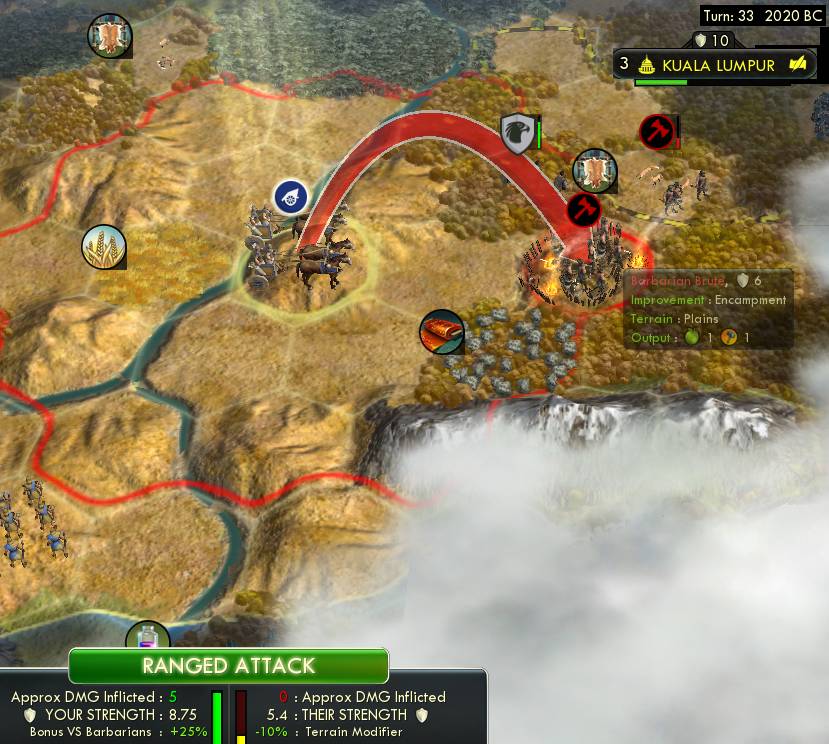
Military notes... I had built one Chariot Archer while researching HBR. He set out south towards a barbarian camp that Kuala Lumpur had complained about. He had to take several turns to clear out a few barb units, and then somebody else cleared the camp to get the credit. That actually happened twice more on other barbarian camps later on. Gradually I realized that a lone ranged unit is exactly the wrong way to go about clearing a camp. ![]() He can't attack until the occupying unit has been shot down, which leaves a window for somebody else to walk into the empty camp.
He can't attack until the occupying unit has been shot down, which leaves a window for somebody else to walk into the empty camp.
Anyway, this took forever after researching Horseback Riding, but my planned Horseman was produced around this time also. He cleared a barb camp for real, retrieving a worker that I'd let get stolen in being unprepared for enemy grunt warriors to have 2 movement. ![]()
I punked a barb camp up north near Monaco, and found myself with enough gold to upgrade the resulting friendly status to Allied. 6 culture per turn? I guess that's useful, although I don't have any sense yet how to efficiently navigate the social policies trees, other than getting the Liberty stuff early.

Masonry then came in, then Construction for colosseums because the happy cap is obviously the limiting factor here. I set Washington to building the Pyramids, just to see if it might work. Other wonders in the Great Library and Stonehenge had fallen already, but I did in time get my wonder. These Pyramids seem to be a no-brainer item to always build if you can, the wonder's cost is barely more than the two workers, and the worker speed and GPP easily put it ahead.
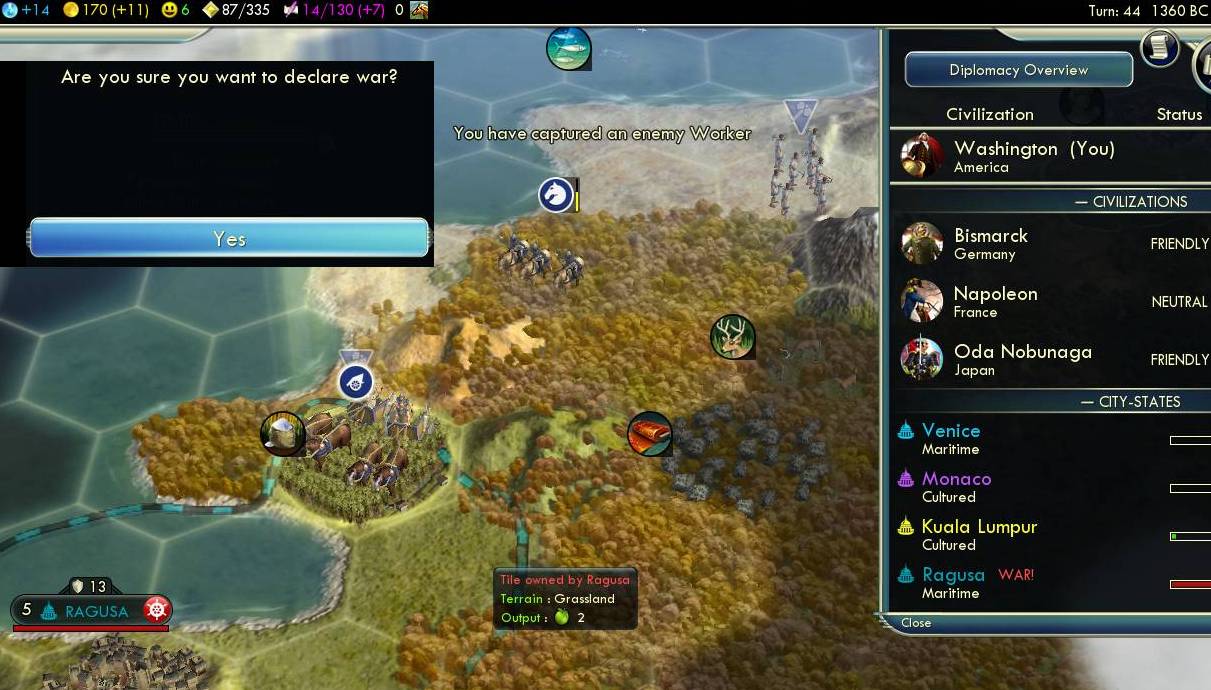
And I couldn't resist this. There was a city-state worker dangling out there unprotected, so I swiped it.
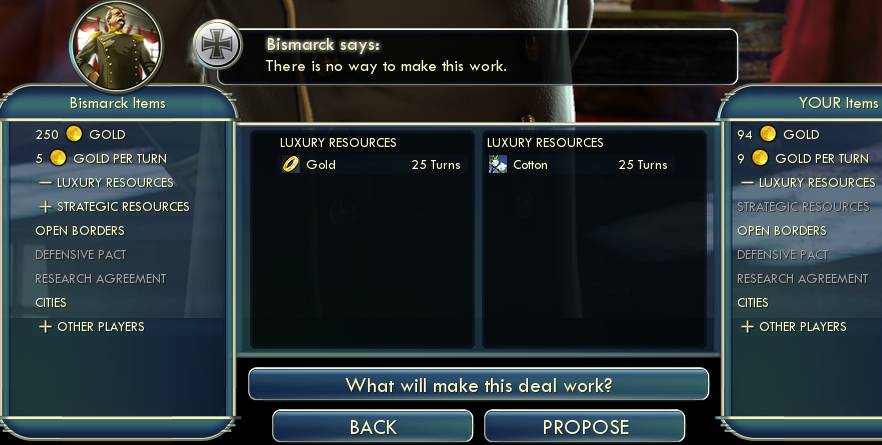
What gives here? Bismarck won't trade luxuries with me? Why? Fortunately, Napoleon traded me furs for that cotton. A while later I realized that the AIs charge much more to sell their last/only copy of a resource, which does make sense, though it would have been nicer if this screen made it a little more obvious.

And there's my first taste of Civ 5 AI insanity. I used my horseman and chariot archer to knock off several German warriors.
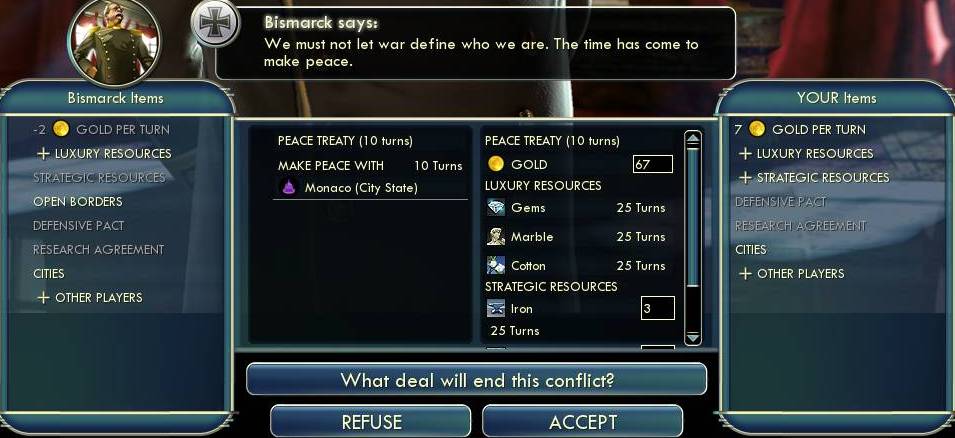
Which made Bismarck come along with this hilariously bad peace deal. A while later he offered a white peace, which I refused since he had some units in range for me to kill that turn. I killed them, then he wouldn't take peace again... weird, do AIs only take white peace if they propose it? Anyway, a while more later he offered white peace again which I took.
